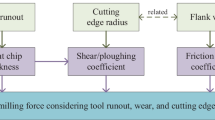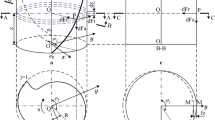Abstract
U pass milling is an efficient rough method that combines the characteristics of flank milling with traditional cycloid milling. This cutting method has the characteristic of smooth cutting force and can meet the requirements of large-depth processing parameters. Cutting force is an important basis for optimizing processing parameters and designing machine tools, cutting tools and fixtures. In this paper, a U pass milling force prediction model considering variable cutting thickness and multi-edge cutting is established. The U pass milling characterization parameters are defined. The tool path is discretized into multiple micro-element trajectories, and a numerical algorithm of instantaneous U pass milling cutting thickness partitioned by trajectory intersection points is proposed. By discretizing the cutting edge curve, the contact criterion of the cutting edge micro-element is established, and the length of instantaneous cutting edge contact area is calculated by searching along the edge curve. According to the distribution state of the upper and lower boundaries of the cutting edge, different forms of multi-edge cutting discrimination methods are proposed. By equal proportion partition of cutting layer, the analytical equation of cutting force coefficient is established, and the coefficient distribution form of variable cutting thickness is obtained. Combined with the micro-element cutting force, the U pass milling force prediction model is obtained by the basis transformation. The milling test result shows that the predicted value is consistent with the measured value of amplitude and trend, which proves the effectiveness of the prediction model in the U pass milling.
























Similar content being viewed by others
Data availability
All data generated or analyzed during this study are included in this published article.
References
Rauch M, Duc E, Hascoet JY (2009) Improving trochoidal tool paths generation and implementation using process constraints modelling. Int J Mach Tools Manuf 49(5):375–383. https://doi.org/10.1016/j.ijmachtools.2008.12.006
Oh NS, Woo WS, Lee CM (2018) A study on the machining characteristics and energy efficiency of Ti-6AI-4V in laser-assisted trochoidal milling. Int J Precis Eng Manuf - Green Technol 5(1):37–45. https://doi.org/10.1007/s40684-018-0004-y
Luo M, Hah C, Hafeez HM (2019) Four-axis trochoidal toolpath planning for rough milling of aero-engine blisks. Chin J Aeronaut 32(08):2009–2016. https://doi.org/10.1016/j.cja.2018.09.001
Santhakumar, Mohammed LU (2019) Parametric Optimization of Trochoidal Step on Surface Roughness and Dish Angle in End Milling of AISID3 Steel Using Precise Measurements. Materials (Basel, Switzerland) 12(8):1335. https://doi.org/10.3390/ma12081335
Hu L, Liu Y, Peng C, Tang WCJ, Tang RZ, Tiwari A (2018) Minimising the energy consumption of tool change and tool path of machining by sequencing the features. Energy 147(15):390–402. https://doi.org/10.1016/j.energy.2018.01.046
Anwar S, Nasr MM, Al-Ahmari A, Alkahtani M, Abdo B (2018) Rotary ultrasonic drilling of Ti6Al4V: effects of machining parameters and tool diameter. Adv Mech Eng 10(1):1–14. https://doi.org/10.1177/1687814017750784
Lmalghan R, Karthik RMC, Arunkumar S, Rao SS, Herbert MA (2018) Machining parameters optimization of AA6061 using response surface methodology and particle swarm optimization. Int J Precis Eng Manuf 19(5):695–704. https://doi.org/10.1007/s12541-018-0083-2
Ding SL, Jiang RD (2004) Tool path generation for 4-axis contour EDM rough machining. Int J Mach Tool Manu 44(14):1493–1502. https://doi.org/10.1016/j.ijmachtools.2004.05.010
Martellotti ME (1941) An analysis of the milling process. Trans ASME 63:677–700 https://www.researchgate.net/publication/238673247_An_analysis_of_the_milling_process
Koenigsberger F, Sabberwal AJP (1961) An investigation into the cutting force pulsation during machining operations. Int J Mach Tool Des Res 1(1-2):15–33. https://doi.org/10.1016/0020-7357(61)90041-5
Tlusty J, MacNeil P (1975) Dynamics of cutting forces in end milling. CIRP Ann 24(1):21–25 https://www.mendeley.com/catalogue/9a16901a-7074-3b98-82b9-3df8fcd9654a/
Kline WA, Devor RE, Lindberg JR (1982) The prediction of cutting forces in end milling with application to cornering cuts. Int J Mach Tool Des Res 22(1):7–22. https://doi.org/10.1016/0020-7357(82)90016-6
Li MY, Ding WB (2016) Research on modeling of variable milling force coefficient for ruled surface in flank milling process. Procedia CIRP 56:178–181. https://doi.org/10.1016/j.procir.2016.10.050
Thangarasu SK, Shankar S, Tony TA, Sridhar G (2018) Prediction of cutting force in turning process—an experimental approach. IOP Conf 310:012119. https://doi.org/10.1088/1757-899X/310/1/012119
Luan X, Zhang S, Li G (2018) Modified power prediction model based on infinitesimal cutting force during face milling process. Int J Precis Eng Manuf - Green Technol 5(1):71–80. https://doi.org/10.1007/s40684-018-0008-7
Shi H, Yuan S, Zhang C, Chen BC, Li QL (2020) A cutting force prediction model for rotary ultrasonic side grinding of CFRP composites considering coexistence of brittleness and ductility. Int J Adv Manuf Technol 106(1):2403–2020. https://doi.org/10.1007/s00170-019-04730-x
Feng Y, Zhang M, Zhu Z, Jia BH, Wang XY (2019) Axial cutting force prediction model of titanium matrix composites TiBw/TC4 in ultrasonic vibration-assisted drilling. Int J Adv Manuf Technol 105(3):121–135. https://doi.org/10.1007/s00170-019-04149-4
Zhang N, Shi Y (2019) A 3-D instantaneous cutting force prediction model of indexable disc milling cutter for manufacturing blisk-tunnels considering run-out. Int J Adv Manuf Technol 103(12):4029–4039. https://doi.org/10.1007/s00170-019-03780-5
Wang J, Zuo J, Shang Z, Fan XL (2019) Modeling of cutting force prediction in machining high-volume SiCp/Al composites. Appl Math Model 70(JUN):1–17. https://doi.org/10.1016/j.apm.2019.01.015
Kim GM, Cho PJ, Chu CN (2000) Cutting force prediction of sculptured surface ball-end milling using Z-map. Int J Mach Tool Manu 40(2):277–291. https://doi.org/10.1016/S0890-6955(99)00040-1
Yun WS, Cho DW (2001) Accurate 3-D cutting force prediction using cutting condition independent coefficients in end milling. Int J Mach Tool Manu 41(4):463–478. https://doi.org/10.1016/S0890-6955(00)00097-3
Li ZZ, Zhang ZH, Zheng L (2004) Feedrate optimization for variant milling process based on cutting force prediction. Int J Adv Manuf Technol 24(7-8):541–552. https://doi.org/10.1007/s00170-003-1700-4
Tsai CL, Liao YS (2010) Cutting force prediction in ball-end milling with inclined feed by means of geometrical analysis. Int J Adv Manuf Technol 46(5-8):529–541. https://doi.org/10.1007/s00170-009-2155-z
Cus F, Zuperl U, Milfelner M (2006) Dynamic neural network approach for tool cutting force modelling of end milling operations. Int J Gen Syst 35(5):603–618. https://doi.org/10.1080/03081070600782022
Wei ZC, Wang MJ, Zhu JN, Zhu LY, Gu LY (2011) Cutting force prediction in ball end milling of sculptured surface with Z-level contouring tool path. Int J Mach Tools Manuf 51(5):428–432. https://doi.org/10.1016/j.ijmachtools.2011.01.011
Li Z, Liu Q, Ming X, Wang X, Dong YF (2014) Cutting force prediction and analytical solution of regenerative chatter stability for helical milling operation. Int J Adv Manuf Technol 73(1-4):433–442. https://doi.org/10.1007/s00170-014-5793-8
Chen H, Li D, Huang S, Fu P (2010) Study on the cutting force prediction of supercritical material milling. In: Sixth International Conference on Natural Computation. IEEE. https://doi.org/10.1109/ICNC.2010.5583674
Li B, Hu Y, Wang X, Li C (2011) Cutting force prediction based on oblique cutting theory in end milling. Zhongguo Jixie Gongcheng/China Mech Eng 22(19):2283–2288. https://doi.org/10.1519/JSC.0b013e3181da7858
Funding
This research is supported by the National Natural Science Funds of China (Grant No. U1908231), the National Natural Science Funds of China (Grant No. 52075076), and the National Natural Science Funds of China (Grant No. 52005078).
Author information
Authors and Affiliations
Contributions
All authors participated in the writing, read and approved the final manuscript.
Corresponding author
Ethics declarations
Competing interests
The authors declare no competing interests.
Additional information
Publisher’s note
Springer Nature remains neutral with regard to jurisdictional claims in published maps and institutional affiliations.
Rights and permissions
About this article
Cite this article
Feng, J., Wei, Z., Wang, M. et al. Force prediction model of high efficiency U pass milling. Int J Adv Manuf Technol 117, 1101–1115 (2021). https://doi.org/10.1007/s00170-021-07707-x
Received:
Accepted:
Published:
Issue Date:
DOI: https://doi.org/10.1007/s00170-021-07707-x




